Hausa people
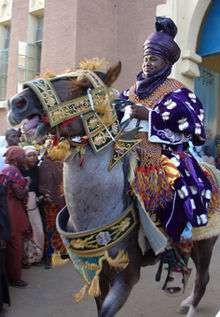 | |
| Total population | |
|---|---|
| Roughly 50 million | |
| Regions with significant populations | |
| Nigeria, Niger, Chad, Ghana,[1] Togo, Benin, Burkina Faso, Cameroon, Côte d'Ivoire, Gabon. | |
| Languages | |
| Religion | |
| Islam | |
| Related ethnic groups | |
| Maguzawa, Azna, Mawri, Gwandara, Ngezzim, Bole, Fula. |
The Hausa (autonyms for singular: Bahaushe (m), Bahaushiya (f); plural Hausawa and general: Hausa/Haoussa; exonyms being Ausa, Mgbakpa, Kado, Al-Takari, Fellata and Abakwariga) are one of the largest ethnic groups in Africa. The Hausa are a diverse but culturally homogeneous people based primarily in the Sahelian and Sudanian Daura area of northern Nigeria and southeastern Niger, with significant numbers also living in parts of Cameroon, Côte d'Ivoire, Chad, Togo, Ghana,[2] Sudan, Gabon and Senegal.
The largest population of Hausa are concentrated in Nigeria and Niger. Predominantly Hausa-speaking communities are scattered throughout West Africa, and on the traditional Hajj route north and east traversing the Sahara Desert, with an especially large population around and in the town of Agadez. Other Hausa have also moved to large coastal cities in the region such as Lagos, Port Harcourt, Accra, Abidjan, Banjul and Cotonou, as well as to parts of North Africa such as Libya over the course of the last 500 years.
Most Hausa, however, live in small villages or towns in Africa, where they grow crops, raise livestock including cattle, and engage in trade. They speak the Hausa language, an Afro-Asiatic language of the Chadic group. The Hausa aristocracy had historically developed an equestrian based culture.[3] Still a status symbol of the traditional nobility in Hausa society, the horse still features in the Eid day celebrations, known as Ranar Sallah (in English: the Day of the Prayer).[4] Daura city is the origin of Hausawa, Hausa people. The town predates all the major Hausa towns in tradition and culture.
Population distribution

A table of Hausa ethnic population by country.[5][6]
| Country | Population |
|---|---|
| 54,000[7] | |
| 556,000[8] | |
| 462,000[9] | |
| 655,000[10] | |
| 224,000[11] | |
| 11,000,000 | |
| 67,000,000 | |
| 35,000[12] |
History
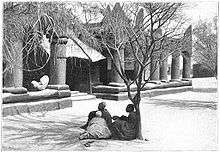
_in_Kano%2C_Nigeria..jpg)
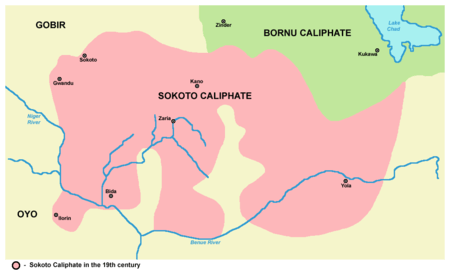
Daura, in northern Nigeria is the oldest city of Hausaland. The Hausa of Sokoto, also in northern Nigeria, speak the oldest surviving classical vernacular of the language.[13] Historically Sokoto was the centre of Hausa Islamic scholarship.[14]
The Hausa are culturally and historically closest to the Fulani, the Zarma and Songhai (in Tillabery, Tahoua and Dosso in Niger) the Kanuri and Shuwa Arab (in Chad, Sudan and northeastern Nigeria); Tuareg (in Agadez, Maradi and Zinder); the Gur and Gonja (northeastern Ghana, northern Togo and upper Benin); Gwari (in central Nigeria), and Mandinka and Soninke who border them to the west of their traditional areas, in Mali, Senegal, Gambia, Ivory Coast and Guinea. Migrants from these areas were introducing Islam to many of the Hausa by the 14th century, although Islam itself has had a presence in Hausaland as early as the 11th century. [15] [16]
All of these groups live in the Sahel, Saharan and Sudanian regions, and as a result have influenced each other's cultures to varying degrees. Today some Fulani people cannot be distinguished from Hausa people in many northern states of Nigeria, due to inter-marriage and cultural assimilation. In Agadez and Saharan areas of central Niger, the Tuareg and Hausa groups are indistinguishable from each other in their traditional clothing; both wear the tagelmust and indigo Babban Riga/Gandora. But the two groups differ in language, lifestyle and preferred beasts of burden (the Tuareg use camels, while Hausa ride horses).[17]
Other Hausa have mixed with ethnic groups such as the Yoruba and Shuwa, incorporating the foods and style of dress into local Hausa customs, as well as heavily influencing the cultures of these groups. Islamic Shari’a law is loosely the law of the land in Hausa areas, well understood by any Islamic scholar or teacher, known in Hausa as a m'allam, mallan or malam (see Maulana). This pluralist attitude toward ethnic-identity and cultural affiliation has enabled the Hausa to inhabit one of the largest geographic regions of non-Bantu ethnic groups in Africa.[18]
The Nok culture appeared in Northern Nigeria around 1000 BC and vanished under unknown circumstances around 300 AD in the region of West Africa. It is believed to be the product of an ancestral nation that branched to create the Hausa, Gwari, Birom, Kanuri, Nupe and Jukun peoples. The Kwatarkwashi Culture or Sokoto Culture located to the North west of Nok is thought to be the same as or an earlier ancestor of the Nok.
Nok's social system is thought to have been highly advanced. The Nok culture is considered to be the earliest sub-Saharan producer of life-sized Terracotta.
The refinement of this culture is attested to by the image of a Nok dignitary at the Minneapolis Institute of Arts. The dignitary is portrayed wearing a "crooked baton" (, ). The dignitary is also portrayed sitting with flared nostrils, and an open mouth suggesting performance. Other images show figures on horseback, indicating that the Nok culture possessed the horse.
Iron use, in smelting and forging for tools, appears in Nok culture in Africa at least by 550 BC and possibly earlier. Christopher Ehret has suggested that iron smelting was independently discovered in the region prior to 1000 BC.[19][20][21]
In the 7th century, the Dala Hill in Kano was the site of a Hausa community that migrated from Gaya and engaged in iron-working.[22] The Hausa began to adopt Islam as early as the 11th century CE although in small numbers. The vast majority still practiced. Hausa Animism at this time. The Hausa Bakwai kingdoms were established around the 7th to 11th centuries. Of these, the Kingdom of Daura was the first, according to the Bayajidda Legend.[23]
The Hausa Kingdoms were independent political entities in what is now Northern Nigeria. The Hausa city states emerged as southern terminals of the Trans-Saharan caravan trade. Like other cities such as Gao and Timbuktu in the Mali Empire, these city states became centers of long distance trade. Hausa merchants in each of these cities collected trade items from domestic areas and from the rain forest region to the south through trade or raiding, processed (and taxed) them and then sent them north to cities along the Mediterranean.[24] The trade influenced political development as ideas (and people) from the Middle East and North Africa made their way south to the cities. In fact the Hausa city state creation myth suggests that northern influence. According to the Bayajidda Legend, the city states began when Bayajidda, a prince of Baghdad, arrived in Daura (the oldest of the Hausa city states) and married the queen of the town. Their seven sons founded the other states of Katsina, Zazzau, Gobir, Kano, Rano, and Biram. These 7 cities are known as the Hausa Bakwai which means Hausa 7.
By the 12th century CE the Hausa were becoming one of Africa's major trading powers, competing with Kanem-Bornu and the Mali Empire.[25] The primary exports were leather, gold, cloth, salt, kola nuts, slaves, animal hides, and henna. Certainly trade influenced religion. By the 14th century, Islam was becoming widespread in Hausaland as Wangara scholars, scholars and traders from Mali and scholars and traders from the Maghreb brought the religion with them.[26]
The architecture of the Hausa is perhaps one of the least known but most beautiful of the medieval age. Many of their early mosques and palaces are bright and colourful, including intricate engraving or elaborate symbols designed into the facade. This architectural style is known as Tubali which means architecture in the Hausa language.
The ancient Kano city walls were built in order to provide security to the growing population. The foundation for the construction of the wall was laid by Sarki Gijimasu from 1095 - 1134 and was completed in the middle of 14th Century. In the 16th century, the walls were further extended to their present position. The gates are as old as the walls and were used to control movement of people in and out of the city. [27]
By the early 15th century the Hausa were using a modified Arabic script known as ajami to record their own language; the Hausa compiled several written histories, the most popular being the Kano Chronicle. Many medieval Hausa manuscripts similar to the Timbuktu Manuscripts written in the Ajami script, have been discovered recently some of them even describe constellations and calendars.[28]
The Gobarau Minaret was built in the 15th century in Katsina. It is a 50-foot edifice located in the centre of the city of Katsina, the capital of Katsina State. The Gobarau minaret, a symbol of the state, is an early example of Islamic architecture in a city that prides itself as an important Islamic learning center. The minaret is believed to be one of West Africa’s first multi-storey buildings and was once the tallest building in Katsina. The mosque's origin is attributed to the efforts of the influential Islamic scholar Sheikh Muhammad al-Maghili and Sultan Muhammadu Korau of Katsina. Al-Maghili was from the town of Tlemcen in present-day Algeria and taught for a while in Katsina, which had become a centre of learning at this time, when he visited the town in the late 15th century during the reign of Muhammadu Korau. He and Korau discussed the idea of building a mosque to serve as a centre for spiritual and intellectual activities. The Gobarau mosque was designed and built to reflect the Timbuktu-style of architecture. It became an important centre for learning, attracting scholars and students from far and wide, and later served as a kind of university. [29]
Muhammad Rumfa was the Sultan of the Sultanate of Kano, located in modern-day Kano State, Northern Nigeria. He reigned from 1463 until 1499.[30] Among Rumfa's accomplishments were extending the city walls, building a large palace, the Gidan Rumfa, promoting slaves to governmental positions and establishing the great Kurmi Market, which is still in use today. Kurmi Market is among the oldest and largest local markets in Africa. It used to serve as an international market where North African goods were exchanged for domestic goods through trans-Saharan trade.[27][31] Muhammad Rumfa was also responsible for much of the Islamization of Kano, as he urged prominent residents to convert.[31]
The legendary Queen Amina (or Aminatu) is believed to have ruled Zazzau between the 15th century and the 16th century for a period of 34 years. Amina was 16 years old when her mother, Bakwa Turunku became queen and she was given the traditional title of Magajiya, an honorific borne by the daughters of monarchs. She honed her military skills and became famous for her bravery and military exploits, as she is celebrated in song as "Amina, daughter of Nikatau, a woman as capable as a man." [32] Amina is credited as the architectural overseer who created the strong earthen walls that surround her city, which were the prototype for the fortifications used in all Hausa states. She subsequently built many of these fortifications, which became known as ganuwar Amina or Amina's walls, around various conquered cities.[33] The objectives of her conquests were twofold: extension of her nation beyond its primary borders and reducing the conquered cities to a vassal status. Sultan Muhammad Bello of Sokoto stated that, "She made war upon these countries and overcame them entirely so that the people of Katsina paid tribute to her and the men of Kano and... also made war on cities of Bauchi till her kingdom reached to the sea in the south and the west." Likewise, she led her armies as far as Kwararafa and Nupe and, according to the Kano Chronicle, "The Sarkin Nupe sent her (i.e. the princess) 40 eunuchs and 10,000 kola nuts." [34]
From 1804-1808, the Fulani, another Islamic African ethnic group that spanned West Africa and shared the area with the Hausa, invaded the Hausa states, starting with Gobir under the leadership of Sheikh Usman Dan Fodio. He declared Jihad on the traditional Habe dynasty kings for their alleged greed, paganism, injustices against the peasant class, use of heavy taxation and violation of the standards of Sharia law. The Fulani and Hausa cultural similarities as a Sahelian people however allowed for significant integration between the two groups. When the Fulani took over the Hausa city-state of Kano during the expansion of the Sokoto Caliphate, the new emirs ended up speaking the Hausa language instead of Fulfulde over the years. Since the early 20th century, these peoples are often classified as "Hausa-Fulani" within Nigeria rather than as individuated groups. In fact a large number of Fulani living in Hausa regions cannot speak Fulfulde at all and speak Hausa as their first language. Many Fulani in the region do not distinguish themselves from the Hausa, as they have long intermarried, they share the Islamic religion and many integrated into Hausa culture. [31]
British General Frederick Lugard used rivalries between many of the emirs in the south and the central Sokoto administration to prevent any defense as he worked toward the capital.[35] As the British approached the city of Sokoto, the new Sultan Muhammadu Attahiru I organized a quick defense of the city and fought the advancing British-led forces. The British forces won, sending Attahiru I and thousands of followers on a Mahdist hijra.[36]
On the 13th of March 1903 at the grand market square of Sokoto, the last Vizier of the Caliphate officially conceded to British Rule. The British appointed Muhammadu Attahiru II as the new Caliph.[36] Lugard abolished the Caliphate, but retained the title Sultan as a symbolic position in the newly organized Northern Nigeria Protectorate.[37] In June 1903, the British defeated the remaining forces of Attahiru I and killed him; by 1906 resistance to British rule had ended. The area of the Sokoto Caliphate was divided among the control of the British, French, and Germans under the terms of their Berlin Conference.
The British established the Northern Nigeria Protectorate to govern the region, which included most of the Sokoto empire and its most important emirates. Under Lugard, the various emirs were provided significant local autonomy, thus retaining much of the political organization of the Sokoto Caliphate.[38] The Sokoto area was treated as just another emirate within the Nigerian Protectorate. Because it was never connected with the railway network, it became economically and politically marginal.[39]
But, the Sultan of Sokoto continued to be regarded as an important Muslim spiritual and religious position; the lineage connection to dan Fodio has continued to be recognized.[37] One of the most significant Sultans was Siddiq Abubakar III, who held the position for 50 years from 1938-1988. He was known as a stabilizing force in Nigerian politics, particularly in 1966 after the assassination of Ahmadu Bello, the Premier of Northern Nigeria.[37]
Following the construction of the Nigerian railway system, which extended from Lagos in 1896 to Ibadan in 1900 and Kano in 1911, the Hausa of northern Nigeria became major producers of groundnuts. They surprised the British, who had expected the Hausa to turn to cotton production. However, the Hausa had sufficient agricultural expertise to realize cotton required more labor and the European prices offered for groundnuts were more attractive than those for cotton. "Within two years the peasant farmers of Hausaland were producing so many tonnes of groundnuts that the railway was unable to cope with the traffic. As a result, the European merchants in Kano had to stockpile sacks of groundnuts in the streets." (Shillington 338).
The Boko script was imposed on the Hausa by the British and French colonial forces and made the official Hausa alphabet in 1930.[40] Boko is a Latin alphabet used to write the Hausa language. The first boko was devised by Europeans in the early 19th century,[41] and developed in the early 20th century by the British (mostly) and French colonial authorities. Since the 1950s boko has been the main alphabet for Hausa.[42] Arabic script (ajami) is now only used in Islamic schools and for Islamic literature. Today millions of Hausa-speaking people, who can read and write in Ajami only, are considered illiterates by the Nigerian government.[43] Despite this, Hausa Ajami is present on Naira banknotes. In 2014, in a very controversial move, Ajami was removed from the new 100 Naira banknote.[44]
Nevertheless, the Hausa remain preeminent in Niger and Northern Nigeria.
Genetics
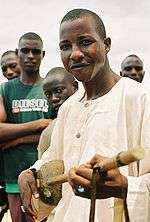
According to a Y-DNA study by Hassan et al. (2008), about 40% of Hausa in Sudan carry the West Eurasian haplogroup R1b. The remainder and majority belong to various Sub-Saharan paternal lineages: 15.6% B, 12.5% A and 12.5% E1b1a. A small minority of around 3% are E1b1b clade bearers, a haplogroup which is most common in North Africa and the Horn of Africa.[45]
In terms of overall ancestry, an autosomal DNA study by Tishkoff et al. (2009) found the Hausa to be most closely related to Nilotic populations from Nigeria, Cameroon, central Chad and South Sudan. This suggests that the Hausa and other modern Chadic-speaking populations originally spoke Nilo-Saharan languages, before adopting languages from the Afro-Asiatic family after migration into that area thousands of years ago.[46]
"From K = 5-13, all Nilo-Saharan speaking populations from Kenya, Tanzania, southern Sudan, and Chad cluster with west-central Afroasiatic Chadic-speaking populations (Fig. S15). These results are consistent with linguistic and archeological data, suggesting a possible common ancestry of Nilo-Saharan speaking populations from an eastern Sudanese homeland within the past ~10,500 years, with subsequent bi-directional migration westward to Lake Chad and southward into modern day southern Sudan, and more recent migration eastward into Kenya and Tanzania ~3,000 ya (giving rise to Southern Nilotic speakers) and westward into Chad ~2,500 ya (giving rise to Central Sudanic speakers) (S62, S65, S67, S74). A proposed migration of proto-Chadic Afroasiatic speakers ~7,000 ya from the central Sahara into the Lake Chad Basin may have caused many western Nilo-Saharans to shift to Chadic languages (S99). Our data suggest that this shift was not accompanied by large amounts of Afroasiatic16 gene flow. Analyses of mtDNA provide evidence for divergence ~8,000 ya of a distinct mtDNA lineage present at high frequency in the Chadic populations and suggest an East African origin for most mtDNA lineages in these populations (S100)."[46]
Culture
Language


The Hausa language has more first-language speakers than any other language in Sub-Saharan Africa. It has an estimated 35 million first-language speakers, and 215 million second-language speakers.[47]
The main Hausa-speaking area is northern Nigeria and Niger. Hausa is also widely spoken in northern Cameroon, Chad, Sudanese Hausa in Sudan and the Ivory Coast among Fulani, Tuareg, Kanuri, Gur, Shuwa Arab and other Afro-Asiatic speaking groups.
There are also large Hausa communities in every major West African city in neighbourhoods called zangos or zongos, meaning "camel-caravan camp" in Hausa (denoting the trading post origins of these communities). Most Hausa speakers, regardless of ethnic-affiliation, are Muslims; Hausa often serves as a lingua franca among Muslims in non-Hausa areas.
There is a large and growing printed literature in Hausa, which includes novels, poetry, plays, instruction in Islamic practice, books on development issues, newspapers, news magazines, and technical academic works. Radio and television broadcasting in Hausa is ubiquitous in northern Nigeria and Niger, and radio stations in Cameroon have regular Hausa broadcasts, as do international broadcasters such as the BBC, VOA, Deutsche Welle, Radio Moscow, Radio Beijing, RFI France, IRIB Iran, and others.
Hausa is used as the language of instruction at the elementary level in schools in northern Nigeria, and Hausa is available as course of study in northern Nigerian universities. Besides, several high degrees (masters and PhD) are offered in Hausa in various universities in the UK, US and Germany. Hausa is also being used in various social media networks around the world.
Hausa ranks as one of the world's major languages, and it has widespread use in a number of countries of West Africa. Hausa's rich poetry, prose, and musical literature, is increasingly available in print and in audio and video recordings. The study of Hausa provides an informative entry into the culture of Islamic West Africa. Throughout West Africa, there is a strong connection between Hausa and Islam.
The influence of the Hausa language on the languages of many non-Hausa Muslim peoples in West African is readily apparent. Likewise, many Hausa cultural practices, including such overt features as dress and food, are shared by other Muslim communities. Because of the dominant position which Hausa language and culture have long held, the study of Hausa provides crucial background for other areas such as West African history, politics (particularly in Nigeria and Niger), gender studies, commerce, and the arts.
Religion
Sunni Islam of the Maliki madhhab is the predominant and historically established religion of the Hausa people. Sizable but visible minorities of Muslims belonging to the Tijani, Mouride and Qadiri sufi tariqas, and more recently, Shia and Salafi groups. Islam has been present in Hausaland as early as the 11th century. The Islamic population grew as the religion was brought by traders and Islamic preachers from North Africa, Borno, Mali and Guinea.
Muslim scholars of the early 19th century disapproved of the hybrid religion practised in royal courts. A desire for reform contributed to the formation of the Sokoto Caliphate.[48] The formation of this state strengthened Islam in rural areas. The Hausa people have been an important factor for the spread of Islam in West Africa. Today, the current Sultan of Sokoto is regarded as the traditional religious leader (Sarkin Musulmi) of Sunni Hausa-Fulani in Nigeria and beyond.
Maguzawa, the African Traditional Religion, was practiced extensively before Islam. In the more remote areas of Hausaland, the people continue to practice Maguzawa. Closer to urban areas, it is not as common, but with elements still held among the beliefs of urban dwellers. Practices include the sacrifice of animals for personal ends, but it is not legitimate to practice Maguzawa magic for harm. People of urbanized areas tend to retain a "cult of spirit possession," known as Bori. It incorporates the old religion's elements of African Traditional Religion and magic.[49]
Clothing
_Benjamin_Stone_cropped.jpg)
The Hausa people have a restricted dress code related to their religious beliefs. The men are easily recognizable because of their elaborate dress which is a large flowing gown known as Babban riga and a robe called a jalabia and juanni (see Senegalese kaftan). These large flowing gowns usually feature some elaborate embroidery designs around the neck. (See Grand boubou for more information).
Men also wear colorful embroidered caps known as hula. Depending on their location and occupation, they may wear a Tuareg-style turban around this to veil the face (known as Alasho or Tagelmust). The women can be identified by wrappers called zani, made with colorful cloth atampa, accompanied by a matching blouse, head tie and shawl.
The Hausa were famous throughout the Middle Ages; they were often characterized by their Indigo blue dressing and emblems. They traditionally rode on fine Saharan camels and Arabian horses.
Architecture
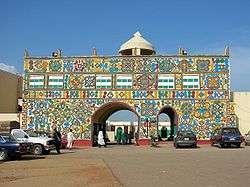
Main article Sudano-Sahelian architecture
Hausa architecture (known as Tubali in the Hausa language) is a distinct sub-style among the various Sudano-Sahelian architectural styles found throughout the Sahel-geographic band stretching from Senegal and Mauritania in the West to Sudan in the east.
Hausa buildings are characterised by the use of dry mud bricks in cubic structures, multi-storied buildings for the social elite, the use of parapets related to their military/fortress building past, and traditional white stucco and plaster for house fronts. At times the facades may be decorated with various abstract relief designs, sometimes painted in vivid colours to convey information about the occupant.
Food
The most common food that the Hausa people prepare consists of grains, such as sorghum, millet, rice, or maize, which are ground into flour for a variety of different kinds of dishes. This food is popularly known as tuwo in the Hausa language.
Usually, breakfast consists of cakes made from ground beans and fried, known as kosai; or made from wheat flour soaked for a day, fried and served with sugar, known as funkaso. Both of these cakes can be served with porridge and sugar known as kunu or koko. Lunch or dinner usually feature a heavy porridge with soup and stew known as tuwo da miya. The soup and stew are usually prepared with ground or chopped tomatoes, onions, and a local pepper sauce called daddawa.
Spices and other vegetables, such as spinach, pumpkin, or okra, are added to the soup during preparation. The stew is prepared with meat, which can include goat or cow meat, but not pork, due to Islamic food restrictions. Beans, peanuts, and milk are also served as a complementary protein diet for the Hausa people.
The most famous of all Hausa food is most likely Suya, a spicy shish kebab like skewered meat which is a popular food item in various parts of Nigeria and is enjoyed as a delicacy in much of West Africa.
A dried version of Suya is called Kilishi.[50]
Literature
A modern literary movement led by female Hausa writers has grown since the late 1980s when writer Balaraba Ramat Yakubu came to popularity. In time, the writers spurred a unique genre known as Kano market literature — so named because the books are often self-published and sold in the markets of Nigeria. Islamic extremism and misogyny have hindered women's ability to work and write openly. However, the subversive nature of these novels, which are often romantic and family dramas that are otherwise hard to find in the Hausa language, have made them popular, especially among female readers. The genre is also referred to as littattafan soyayya, or "love literature."[51]
Hausa symbolism
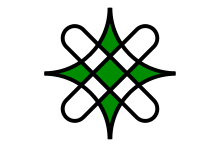

A proposed Hausa ethnic flag is a banner with five horizontal stripes—from top to bottom they are red, yellow, indigo blue, green, and khaki beige.[52] The older and traditionally established motif of Hausa identity, the eternal knot in a star shape, is used in historic architecture, design and embroidery.
Notable Hausa People
- Abdulkareem Baba Aminu
- Abdulsalami Abubakar
- Abubakar Imam Kagara
- Ahmed Musa
- Aisha Augie-Kuta
- Alhaji Abdulsamad Rabiu
- Alhaji Alhassan Dantata
- Alhaji Baba Kusa
- Alhaji Aliko Dangote
- Alhaji Isyaku Rabiu
- Alhaji Mamman Shata Katsina
- Alhaji Sayyu Dantata
- Alhaji Umaru Mutallab
- Ali Nuhu
- Amadou Moutari
- Amina Sukhera
- Aminu Umar
- Attahiru Jega
- Bello Hamisu Ida
- Dan Maray Jos
- Daouda Malam Wanké
- Haruna Babangida
- Yusuf Bello Maitama
- Bello Maitama
- Ibrahim Baré Maïnassara
- Ibrahim H. Umar
- Mahamadou Issoufou
- Mahamane Ousmane
- Moussa Maâzou
- Muhammad Rumfa
- Murtala Muhammed
- Musa Mai Sana'a
- Rabilu Musa Dan Ibro
- Sani Kaita
- Shamsuddeen Usman
- Shehu Abdullahi
- Tijani Babangida
- Umar Farouk Abdulmutallab
- Umar Sadiq
- Zaynab Alkali
- Tukur Abubakar
- Alhaji Uba Dansaja
- Alhaji Alhasan Dantata
References
- ↑ Joshua Project. "Hausa in Ghana". Retrieved 4 November 2015.
- ↑ "Zango FM". Retrieved 4 November 2015.
- ↑ "The role of the horse in Hausa culture". Retrieved 4 November 2015.
- ↑ "» Horse Talk: Horse Breeding in Niger Esther Garvi: Niger, West Africa". Retrieved 4 November 2015.
- ↑ "Ethnologue.com entry for Hausa". Retrieved 2011-07-25.
- ↑ (French) http://www.tlfq.ulaval.ca/axl/monde/famarabe.htm
- ↑ "PeopleGroups.org - Hausa". PeopleGroups.org.
- ↑ "PeopleGroups.org - Hausa". PeopleGroups.org.
- ↑ Joshua Project. "Hausa in Chad".
- ↑ Joshua Project. "Hausa in Ghana".
- ↑ Joshua Project. "Hausa in Cote d'Ivoire".
- ↑ "PeopleGroups.org - Hausa". PeopleGroups.org.
- ↑ "Hausa Dialect Frame". Retrieved 4 November 2015.
- ↑ http://www.gamji.com/article6000/NEWS6032.htm
- ↑ http://www.saylor.org/site/wp-content/uploads/2012/10/HIST101-10.2.2-HausaKingdom-FINAL1.pdf
- ↑ "Islam in Nigeria". Retrieved 4 November 2015.
- ↑ "Agadez Sultanate of the Sahara", Saudi Aramco World, January 2003
- ↑ "404 Error Page - University of Liverpool" (PDF). Retrieved 4 November 2015.
- ↑ Jared Diamond, 'Guns, Germs, and Steel: The Fates of Human Societies' (1997) Chapter 19
- ↑ Duncan E. Miller and N.J. Van Der Merwe, 'Early Metal Working in Sub Saharan Africa' Journal of African History 35 (1994) 1-36
- ↑ Minze Stuiver and N.J. Van Der Merwe, 'Radiocarbon Chronology of the Iron Age in Sub-Saharan Africa' Current Anthropology 1968. Tylecote 1975 (see below)
- ↑ Administrator. "Historical Origins of Kano". Retrieved 4 November 2015.
- ↑ Iliffe, John (2007). Africans: The History of a Continent. Cambridge University Press. p. 75. ISBN 0-521-86438-0.
- ↑ "Hausa City States (Nigeria) - The Black Past: Remembered and Reclaimed". Retrieved 4 November 2015.
- ↑ Hogben/Kirk-Greene, Emirates, 82-88; Lange, Kingdoms, 216-221, 554 n. 25.
- ↑ Administrator. "Spread of Islam in West Africa (part 3 of 3): The Empires of Kanem-Bornu and Hausa-Fulani Land". Retrieved 4 November 2015.
- 1 2 whc.unesco.org/en/tentativelists/5171/
- ↑ "Saudi Aramco World : From Africa, in Ajami". Retrieved 4 November 2015.
- ↑ zodml.org/discover-nigeria/heritage-and-culture/gobarau-minaret#.VTGE1yHBzGc
- ↑ "50 Greatest Africans - Sarki Muhammad Rumfa & Emperor Semamun". When We Ruled. Every Generation Media. Retrieved 2007-05-05.
- 1 2 3 "Caravans Across the Desert: Marketplace". AFRICA: One Continent. Many Worlds. Natural History Museum of Los Angeles County Foundation. Archived from the original on 2007-09-30. Retrieved 2007-05-06.
- ↑ "History and Women: Amina of Zaria". Retrieved 4 November 2015.
- ↑ blackhistorypages.net/pages/amina.php
- ↑ "Queen Amina & Queen Bakwa Turunku". Retrieved 4 November 2015.
- ↑ The Cambridge History of Africa: 1870-1905. London: Cambridge University Press. 1985. p. 276.
- 1 2 Falola, Toyin (2009). Colonialism and Violence in Nigeria. Bloomington, IN: Indiana University Press.
- 1 2 3 Falola, Toyin (2009). Historical Dictionary of Nigeria. Lanham, Md: Scarecrow Press.
- ↑ Claire Hirshfield (1979). The diplomacy of partition: Britain, France, and the creation of Nigeria, 1890-1898. Springer. p. 37ff. ISBN 90-247-2099-0. Retrieved 2010-10-10.
- ↑ Swindell, Kenneth (1986). "Population and Agriculture in the Sokoto-Rima Basin of North-West Nigeria: A Study of Political Intervention, Adaptation and Change, 1800-1980". Cahiers d'Études Africaines. 26: 75–111. doi:10.3406/cea.1986.2167.
- ↑ Dalby, Andrew (1998). Dictionary of languages: the definitive reference to more than 400 languages. New York: Columbia University Press. p. 242. ISBN 0-231-11568-7.
- ↑ Awoyale, Yiwola; Planet Phrasebooks, Lonely. Africa: Lonely Planet Phrasebook. Lonely Planet. p. 79. ISBN 1-74059-692-7.
- ↑ "Hausa language, alphabets and pronunciation". Retrieved 4 November 2015.
- ↑ "Saudi Aramco World : From Africa, in Ajami". Retrieved 4 November 2015.
- ↑ 247nigerianewsupdate.co/in-defense-of-muric-bring-back-our-ajami-by-abdulbaqi-aliyu-jari/
- ↑ Hassan, Hisham Y. et al. 2008 "Y-Chromosome Variation Among Sudanese: Restricted Gene Flow, Concordance With Language, Geography, and History"
- 1 2 Williams, Floyd A. (2009). "The Genetic Structure and History of Africans and African Americans". Science. 324 (5930): 1035–44. Bibcode:2009Sci...324.1035T. doi:10.1126/science.1172257. PMC 2947357
 . PMID 19407144
. PMID 19407144 - ↑ Nationalencyklopedin "Världens 100 största språk 2007" (The World's 100 Largest Languages in 2007), SIL Ethnologue
- ↑ Robinson, David, Muslim Societies in African History (Cambridge, 2004), p141
- ↑ Adeline Masquelier. Prayer Has Spoiled Everything: Possession, Power, and Identity in an Islamic Town of Niger. Duke University Press (2001) ISBN 978-0-8223-2639-7
- ↑ Agence France-Presse (22 May 2012). "Nigerian roadside barbecue shacks thrive in the midst of Islamist insurgency". The Raw Story. Retrieved 5 April 2014.
- ↑ Laura Mallonee, The Subversive Women Who Self-Publish Novels Amid Jihadist War, Wired, 17 February 2016.
- ↑ Hausa ethnic flag:
Bibliography
- Bivins, Mary Wren. Telling Stories, Making Histories: Women, Words, and Islam in Nineteenth-Century Hausaland and the Sokoto Caliphate (Portsmouth, New Hampshire, Heinemann, 2007) (Social History of Africa).
- Being and becoming Hausa: interdisciplinary perspectives. African social studies series. Anne Haour, Benedetta Rossi (eds.). Leiden ; Boston: Brill. 2010. ISBN 9789004185425.
- Salamone, Frank A. (2010). The Hausa of Nigeria. Lanham, MD: University Press of America. ISBN 9780761847243.
External links
| Wikimedia Commons has media related to Hausa people. |
- All hausa food recipes
- Internet Forum for the Hausaland Community
- Hausa Information at Art and Life in Africa Online